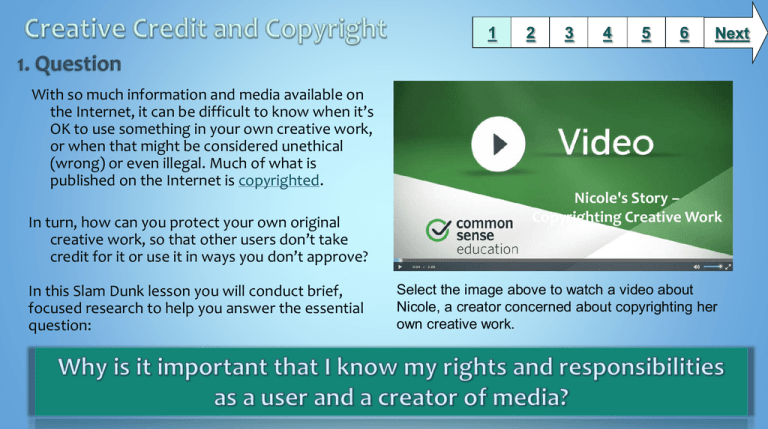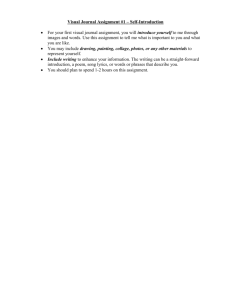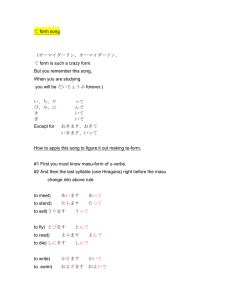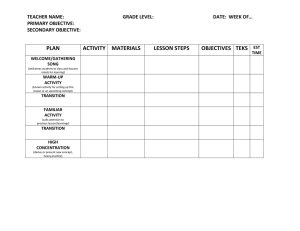
1
2
3
4
5
6
Next
With so much information and media available on
the Internet, it can be difficult to know when it’s
OK to use something in your own creative work,
or when that might be considered unethical
(wrong) or even illegal. Much of what is
published on the Internet is copyrighted.
In turn, how can you protect your own original
creative work, so that other users don’t take
credit for it or use it in ways you don’t approve?
In this Slam Dunk lesson you will conduct brief,
focused research to help you answer the essential
question:
Nicole's Story –
Copyrighting Creative Work
Select the image above to watch a video about
Nicole, a creator concerned about copyrighting her
own creative work.
1
2
3
4
5
6
Next
Use the information sources here to learn
more about copyright and creative credit
and to complete the Student Activity on
Slide 3.
Copyright BrainPop video– Before selecting this
link, log into BCPSOne and click on Digital Content >
BrainPop icon to authenticate.
Questions about Copyright from Cyberbee
Copyright Basics from Copyright Kids
Taking the Mystery Out of Copyright - Animated
videos from the Library of Congress
Copyright and Creative Commons – Explainer
video from Common Craft
Fair Use poster
Protected by Copyright digital slider
Copyright & Fair Use
Select the image above to learn from a video
about Copyright and Fair Use
- from Common Sense Media
Reading Levels:
Basic (on or below grade level)
Challenge me! (above grade level)
1
Using information from the sources on Slide 2,
figure out the meaning of each of the
words in the word bank on this worksheet.
Complete each sentence by entering the
correct word from the word bank into the
space provided in each sentence.
You will submit your finished work to your
teacher when you are finished. Your
teacher will provide directions about how
to submit your work.
2
3
4
5
6
Next
Henry's Story Making Mashups
Select the image above to learn from a video about
Henry, a content creator concerned about copyright
infringement.
1
2
3
4
5
6
Next
Take the BrainPop Copyright Quiz
One popular song that almost never appears in movies or on
TV is the Happy Birthday Song! Read this ARTICLE to find
out why. Then use this songwriting PLANNER to create a
new and unique version of a birthday song. Be really
creative, and remember that originality is key.
When you are finished writing your song, discuss with your
group what kind of copyright license you might want to
use to share or protect the rights to your song. Refer to
this Creative Commons informational flye to help you
decide.
The New
Happy Birthday
Song Contest!
Lastly, think about how you may want to perform your song
for the class! You could perform as a live group, or record Select the image above to visit a webpage
the song using a recording tool/software like Vocaroo,
where you can listen to submissions for a New
Audacity, the Sound Recorder on your HP Revolve Device, Happy Birthday Song Contest, on FMA
or your own favorite smart device sound recording app.
Cake Image from Flickr Creative Commons
1
2
3
4
5
6
Next
Fair Use Collage:
Cut out (copyrighted) images from magazines.
Using glue and construction paper, mix
images together into a collage. Rework and
change the images to create a new, original
work that would qualify for fair use of the
copyrighted material. Display your collage on
the classroom walls and have everyone look
at the work.
Examine how well each collage fits the key points
of fair use. Then vote for the “best fair use
collage” in class. Refer to the Four Points of
Fair Use to double check that you are using
your images fairly.
Select the image above to view a larger
infographic about copyright symbol
meanings. From GCF Learn Free Blog Basics
Share the Common Sense on Respecting
Creative Work Tip Sheet from CSM with your
family.
1
Common Core State Standards
grade 6: RI.2, RI.3, RI.7, RI.8, RI.10, W.4, W.10, SL.1a, SL.1b, SL.1c, SL.1d, SL.2, SL.6, L.6
grade 7: RI.2, RI.3, RI.8, RI.10, W.4, W.10, SL.1a, SL.1b, SL.1c, SL.1d, SL.2, SL.6, L.6
grade 8: RI.2, RI.3, RI.8, RI.10, W.4, W.10, SL.1a, SL.1b, SL.1c, SL.1d, SL.2, SL.6, L.6
Standards for the 21st Century Learner
1.1.6 Read, view, and listen for information presented in any format (e.g. textual, visual, media, digital) in order
to make inferences and gather meaning.
2.1.3 Use strategies to draw conclusions from information and apply knowledge to curricular areas, real-world
situations, and further investigations.
3.1.6 Use information and technology ethically and responsibly.
ISTE Standards for Students
3. Research and Information Fluency: Students apply digital tools to gather, evaluate, and use information.
b. Locate, organize, analyze, evaluate, synthesize, and ethically use information from a variety of sources
and media.
4. Critical Thinking, Problem Solving, and Decision Making: Students use critical thinking skills to plan and
conduct research, manage projects, solve problems, and make informed decisions using appropriate digital
tools and resources. c. Collect and analyze data to identify solutions and/or make informed decisions.
5. Digital Citizenship: Students understand human, cultural, and societal issues related to technology and
practice legal and ethical behavior. a. Advocate and practice safe, legal, and responsible use of
information and technology.
P21 Skills
Information, Media & Technology Skills:
Apply a fundamental understanding of the ethical/legal issues surrounding the access and use of information
technologies
Access information efficiently (time) and effectively (sources); Use information accurately and creatively for the
issue or problem at hand.
2
3
4
5
6
Grades 6-8 Library Media / Digital Citizenship
Time Frame:
1 hour for research, 1 hour to create research product.
Differentiation strategies for this lesson:
Some materials in this lesson are also available in Spanish
on the Common Sense Media website.
Information sources on Slide 2 are in a variety of media
formats to address various learning preferences.
Students could work with a partner or small group to
complete the Student Activity on Slide 3 and/or the
assessment on Slide 4.
Notes to the teacher:
Collaborate with your school library media specialist to
implement this lesson.
Provide students with instructions for how to turn in their
work, either electronically or on paper.
Lesson content used or adapted from the Common Sense
Media lessons A Creator’s Rights, A Creator’s Responsibilities,
and Rework, Reuse, Remix. See the Creator’s Rights lesson for
answer keys/teacher’s guides for the Student Activity and
Assessment Activity. Please review these lessons before
implementing the SlamDunk research model to gain a broader
scope of the lesson content.
See the Teaching & Learning Resources section of the
Copyright & Fair Use page on our ODL Resource wiki for
additional resources.
Last updated: July 2015
Created by Amber Bickhart, BCPS School Library Media Intern, Revised by Anna Conner, Library Media Specialist
BCPS Slam Dunk Research Model, Copyright 2014, Baltimore County Public Schools, MD, all rights reserved. The models may be used for educational, non-profit school use only.
All other uses, transmissions, and duplications are prohibited unless permission is granted expressly. This lesson is based on Jamie McKenzie’s Slam Dunk Lesson module.



